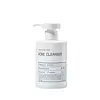What's inside
What's inside
 Key Ingredients
Key Ingredients

No key ingredients
 Benefits
Benefits

 Concerns
Concerns

 Ingredients Side-by-side
Ingredients Side-by-side

Water
Skin ConditioningSodium Laureth Sulfate
CleansingGlycerin
HumectantMyristic Acid
CleansingCocamidopropyl Betaine
CleansingLauric Acid
CleansingLauramide DEA
Potassium Hydroxide
BufferingButylene Glycol
HumectantSalicylic Acid
MaskingGlyceryl Caprate
EmollientPolyglyceryl-2 Laurate
EmulsifyingPolyglyceryl-10 Laurate
Skin ConditioningPEG-150 Pentaerythrityl Tetrastearate
EmulsifyingLavandula Angustifolia Oil
MaskingAloe Barbadensis Leaf Extract
EmollientCamellia Sinensis Leaf Extract
AntimicrobialTetrasodium EDTA
Methylparaben
PreservativeLinalool
PerfumingWater, Sodium Laureth Sulfate, Glycerin, Myristic Acid, Cocamidopropyl Betaine, Lauric Acid, Lauramide DEA, Potassium Hydroxide, Butylene Glycol, Salicylic Acid, Glyceryl Caprate, Polyglyceryl-2 Laurate, Polyglyceryl-10 Laurate, PEG-150 Pentaerythrityl Tetrastearate, Lavandula Angustifolia Oil, Aloe Barbadensis Leaf Extract, Camellia Sinensis Leaf Extract, Tetrasodium EDTA, Methylparaben, Linalool
 Reviews
Reviews

Alternatives
Ingredients Explained
These ingredients are found in both products.
Ingredients higher up in an ingredient list are typically present in a larger amount.
Butylene Glycol (or BG) is used within cosmetic products for a few different reasons:
Overall, Butylene Glycol is a safe and well-rounded ingredient that works well with other ingredients.
Though this ingredient works well with most skin types, some people with sensitive skin may experience a reaction such as allergic rashes, closed comedones, or itchiness.
Learn more about Butylene Glycol